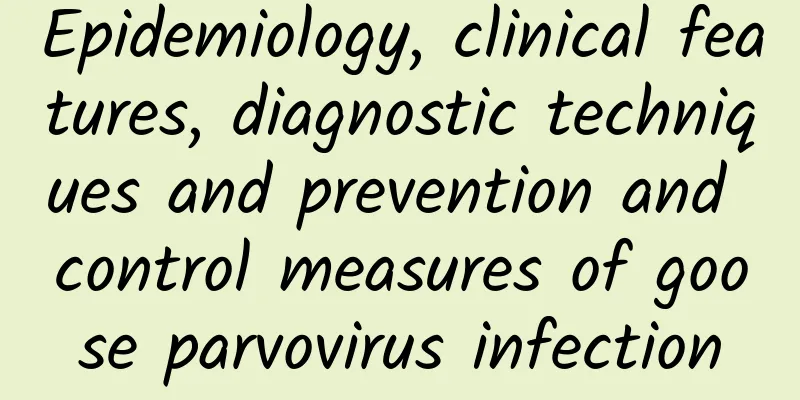Epidemiology, clinical features, diagnostic techniques and prevention and control measures of goose parvovirus infection

|
1 Epidemiology Pathogen. Goose parvovirus (GPV) is a member of the Parvoviridae family and the Parvovirus genus. Its biological characteristics are similar to those of Muscovy duck parvovirus. Through electron microscopy, it was found that the virus particles are round or hexagonal, arranged in an icosahedral symmetrical lattice, with a diameter of about 20 to 24 nm. It has no envelope and is a DNA virus. Because the virus does not have an envelope, it has a strong ability to resist the environment. For example, it will be inactivated after heating at 56°C for 3 hours, and it is insensitive to trypsin, detergents, and low pH conditions. Susceptible animals. Under natural infection conditions, only goslings and Muscovy ducklings can be infected, while other birds and mammals will not be infected. Goslings aged 3 to 20 days are susceptible, and there are certain differences in the incidence and mortality rates among geese of different ages, different immune conditions, and different regions, but the younger the age, the higher the mortality rate. Transmission route. The disease is mainly transmitted through the fecal-oral route, that is, the main mode of transmission of the disease is direct contact with sick geese or mechanical transmission through virus-contaminated feed, utensils, breeding eggs, etc. 2 Clinical symptoms and autopsy changes 2.1 Clinical symptoms For goslings under 15 days of age, whether naturally or artificially infected, the incubation period is usually 3 to 5 days; for susceptible goslings older than 15 days of age, whether naturally or artificially infected, the incubation period is 1 to 2 days longer than the former. The disease mainly causes symptoms in the digestive system and nervous system of sick geese. It can be divided into three types according to the duration of the disease, namely the most acute type, acute type and subacute type. The most acute type. It is more common in goslings under 7 days old, and they often develop the disease suddenly and die quickly. They usually become weak within a few hours after becoming depressed, or fall to the ground with their legs flailing around, and die quickly. In addition, there is a small amount of serous secretion in the nostrils of the sick goslings, which will spread to the entire flock in just a few days. Acute type. It is more common in goslings aged 7 to 14 days. After falling ill, the main symptoms are depression, loss of appetite or complete insomnia. After about 12 hours, the sick geese often look dull, shrink their necks and close their eyes, move slowly and weakly, cannot stand steadily, often squat, stop eating, but increase drinking water, and excrete yellow-green or yellow-white loose feces, and the feces are attached to the anus. In addition, the sick geese breathe with their mouths open, the area around their nostrils is dirty, the tip of their beaks is cyanotic, the webbed webs are dull, the crop becomes soft, there are liquids and bubbles inside, the body is dehydrated, the conjunctiva is dry, and they eventually die of shock. Before death, they will have convulsions or paralysis of both legs. The course of the disease usually lasts about 2 days. Subacute type. Usually appears in the late stage of the epidemic, and is more common in goslings older than 14 days old. After becoming ill, they show low spirits, reduced or stopped eating, secretions from the nostrils, slow movements, inability to stand steadily, often squatting, accompanied by diarrhea, and feces contaminating the area around the anus. The course of the disease lasts slightly longer, usually 3 to 7 days or longer, and can heal on its own. 2.2 The changes observed during autopsy are mainly intestinal lesions, i.e., all segments of the small intestine are congested and severely swollen, with a large amount of mucus, a small amount of egg-drop-like yellow-white cellulose exudate on the mucosa, and a layer of light yellow pseudomembrane covering the middle and lower intestinal segments. Sometimes thin strips of coagulants can be seen, causing the small intestine to present a "sausage-like" lesion. The most acute type. Autopsy shows that the duodenal mucosa is diffusely red due to congestion, and there is a large amount of mucus on the surface. Acute type. Autopsy shows characteristic lesions in the intestine, mostly in the middle and lower segments of the small intestine, especially the segments close to the ileocecal region and the yolk sac stalk, which are obviously swollen in appearance, and their volume can often reach 3 to 4 times that of normal segments, like sausages, and feel firm. Cutting open the intestinal wall at the swollen part, it is found that the intestinal wall is thin and tense, and there are coagulated light yellow or light gray emboli in the intestinal cavity, which are composed of coagulated fibrinous exudates and necrotic intestinal mucosal tissue, causing the intestinal cavity to be completely blocked. Subacute type. The autopsy mainly shows acute catarrhal enteritis, with the liver being yellow-red or dark purple-red and swollen, the gallbladder being significantly enlarged and containing a large amount of dark green bile; the spleen and pancreas are both congested, and sometimes there are gray-white necrotic spots. 3 Laboratory diagnostic techniques 3.1 Serological diagnostic techniques Virus neutralization test. Its basic principle is antigen-antibody reaction, that is, after the key sites of the virus bind to the corresponding antibodies, it cannot be adsorbed and infected normally, and thus cannot cause cytopathic effect (CPE). This is the most commonly used serological diagnostic method. Enzyme-linked immunosorbent assay (ELISA). This method is currently one of the most commonly used detection technologies in the field of biology, and has gradually been used as a routine means to detect pathogens prevalent in animals. This technology has the advantages of good safety, simple operation, high sensitivity, and rapid results. Commonly used methods include double sandwich ELISA and spot ELISA. It usually only takes 3 to 4 hours to make a diagnosis, which is suitable for early diagnosis in geese. However, since this technology requires the preparation of monoclonal antibodies, its promotion in the clinical practice of primary veterinary medicine is subject to certain restrictions. Immunofluorescence diagnostic method. This method includes direct fluorescence method and indirect fluorescence method. Among them, direct fluorescence method is the most commonly used inspection method in the laboratory. It refers to labeling fluorescein on antibodies or antigens and using it for antigen-antibody reaction. It is characterized by high sensitivity, good specificity, and short time consumption. However, due to the problem of non-specific staining, the judgment results are relatively subjective. Indirect immunofluorescence method refers to making the diseased material to be tested into touch pieces or slices, and then dripping standard anti-GPV negative and positive serum respectively, and finally adding fluorescently labeled secondary antibodies for color development, but it requires the use of a fluorescence microscope. Colloidal gold immunochromatography technology. This technology has been applied in many aspects of testing. Its advantages are simple operation, no need for complex instruments, strong specificity, high sensitivity, and intuitive test results. 3.2 Molecular Biological Detection Technology PCR technology. This technology is the most sensitive detection method among various virological diagnostic technologies. Its advantages are good specificity and the ability to detect a large number of specimens at one time without the need for virus separation and purification. In situ hybridization technology. This technology uses a digoxin-labeled GPVSS DNA probe to detect goose parvovirus. This is because the probe can only react positively with the nucleic acid of the virus, and will not react with goose embryo allantoic fluid, normal goose embryo tissue, goose liver and other tissues. Therefore, it has very high sensitivity and strong specificity. In addition, this technology can accurately and quickly detect the presence of goose parvovirus nucleic acid, and has high repeatability. Circular isothermal amplification technology. The key point of this technology is to design 4 specific primers for 6 regions of the target fragment, and use chain displacement DNA polymerase to efficiently amplify the target fragment under a constant temperature of about 65°C. Its advantages are simple operation, high sensitivity, strong specificity, short time consumption, etc., and no expensive instruments are required. Only a water bath is needed to complete the operation. It is usually applicable to laboratory diagnosis in primary veterinary departments and clinical diagnosis in the field. 4 Prevention and Control Measures 4.1 Epidemic Handling Sick geese must be isolated immediately after discovery. Dead geese must be buried deeply. Clean the goose house first, then rinse with high-pressure water, and then spray with 2% sodium hydroxide solution for disinfection. At the same time, soak the feeding troughs and waterers in 1% potassium permanganate solution for disinfection. The geese must also be disinfected at least 3 times a week for 2 consecutive weeks. For goslings that are not sick, 0.5-0.8 mL of high-titer antiserum or 1.0 mL of refined egg yolk antibody can be injected subcutaneously for each gosling. Note that an appropriate amount of broad-spectrum antibiotics can be added to the serum or egg yolk antibody. For sick goslings, 1.0 mL of high-titer antiserum or 1.5 mL of refined egg yolk antibody can be injected subcutaneously for each gosling. At the same time, 4 g of electrolyte multivitamin mixed drink can be added per kilogram of drinking water. This can increase the cure rate and reduce the occurrence of stress. 4.2 Vaccination At present, the main way to prevent the occurrence of this disease is to immunize the geese with goose parvovirus vaccine. Both live vaccine and inactivated vaccine can be used. Among them, inactivated vaccine has the advantages of safety, easy storage and long immunity period, and is suitable for clinical application. Recommended immunization program: The first vaccination for breeding geese is 20 days before laying, and the second vaccination is 120 days old, with each goose receiving 1 mL of vaccine each time; the first vaccination for goslings is 3 days old, with each gosling receiving 0.5 mL of vaccine, and the second vaccination is 90 days old, with each gosling receiving 1.0 mL of vaccine. For goslings without maternal antibodies, since there will be an antibody blank period, it is best to use high-immune serum or yolk antibodies after hatching to prevent disease. |
>>: Correctly understand the "wealth bag"
Recommend
Is it better to remove the accessory breast or liposuction?
There are two types of axillary accessory breast....
What causes dizziness at 32 weeks of pregnancy?
We all know that when a woman reaches the 32nd we...
Is surgery necessary for mastitis with suppuration?
There are many methods for treating suppurative m...
Placenta previa, how much do you know?
Placenta previa is a pregnancy complication that ...
What is labor pain
From the first day a woman finds out she is pregn...
What kind of eyebrows should I get for my face shape?
More and more people pay more attention to the ch...
What are the symptoms of breast lymph nodes
Mammary lymph node disease is a relatively common...
Is it normal to have small polyps on the vulva?
Women should pay close attention to their health ...
How many days after stopping dydrogesterone do you get your period?
Dydrogesterone can be used to treat symptoms caus...
A small amount of uterine fluid after abortion
Since some couples do not take proper precautions...
Crawley Brand Social Media Rankings in August 2022
In the Internet age, the influence of social medi...
Menstruation delayed for 21 days and no pregnancy test
If your period is delayed and you have had sex re...
Vaginal bleeding at 12 weeks of pregnancy
A woman's body is in a relatively important s...
What causes dry stools in women?
Everyone has experienced constipation, but many p...
Can I eat Gorgon fruit during breastfeeding?
The diet during lactation is the same as that dur...









